We have assigned ourselves a list of architecturally interesting churches. Our hotel is about five hundred feet from the first one: Santa Maria presso San Satiro (1476-82) by Donato Bramante.The first one might be the best one. We walk around the back, at first, not able to find the front, which we eventually locate down a short narrow alley from Via Torino. Because of the street behind the church, there is no room for a full cruciform-plan, so Bramante uses a false "compressed" perspective to provide the illusion of one. The poly-chrome and the surface patterns seem to help by giving your eye a lot to deal with – though you never feel overwhelmed. It just feels a much-much bigger than it actually is.
Other analytical notes indicate that this is an example of tromp l'oeil; but I'd argue that this is not an illusionistic image painted on a flat surface. This is a collapsed perspective relief, similar in spirit to the stage-piece at the Teatro Olimpico by Scamozzi, though done as much for showmanship as practicality, in Bramante's case.
Just to the left of the altar is a wonderful ancient chapel; made of parts from various periods and styles it is still a quiet and compelling room that helps tell the history of the church. Closer to the entry, and to the right is the baptistry, a second domed space, with an open and clean, if formally grand, feel. It's a lot of church jammed into minimal space, and a true triumph of both architectural expression and efficiency.
Fun tourist tip: you can put a euro into a paybox, and the lights will come on in both the main church and the small ancient chapel – totally worth it, though, on the other hand, as the morning light really started to hit the church, the interior did magically begin to glow on its own.
Just a four minute walk down Via Torino from San Satiro is the Civico Tempio di San Sebastiano, designed by Pellegrino Tibaldi, with construction started in 1576. This is a large, dark, central space, and a smaller domed altar area. The external forms are quite striking, like a set of drums sacked like a cake, there is a paired-Doric base, a transitional paired-bracketed layer, and a scaled-down paired-Ionic cap; next to that is the hemispherical dome of the altar. On the inside the pairs become singles, but the theme itself carries, with the straps of the dome taking the place of the columns. It seems grey and serious.
Another odd imposition: the front door now leads out to the side of the adjacent building; there is a delivery truck parked there, too, making things even more awkward. It seems a sign that the Milanese do not mind jamming churches into tight spaces, or building new around old, regardless the consequences or inconvenient contrast.
The walk to the Basilica San Lorenzo Maggiore is quite a bit longer (about 15 minutes), southwest, down Via Torino to north-most end of a large, grassy park – to which we cannot gain access. Our approach is from the side, and we need to walk almost all the way around to a very old-looking stone and brick forecourt. Just outside we found a wonderful artist's studio, where Guido de Zan makes mostly ceramic pieces, but also lots of other delightful objects, with hints of Brice Marden, Cy Twombly, and Constantin Brancusi.
Once we find the door to the church, we discover a tremendous collection of architectural spaces and eras. The primary church space is a double-shell octagon or "rounded-square"; it's large, clean, and very solid-looking. On each side of the octagon is a different added-on space – different in size, scale, and character. The first one we find is a barrel-vaulted room; simple, and grandly-scaled, it's full of possibilities as there are some intriguing old frescos that are being restored. Hop-scotching the perimeter, we find a small chapel with more bits of ancient artwork; this little chapel is just warm and comfortable. Another room offers a partially finished, rather wild, baroque-like domed ceiling fresco that spills down its arches. Yet another small chapel is styled like a neoclassical sitting room. From the exterior, you can read the same layering and additive process of building; it's fascinating.
Another short walk through a tangle of knotted street to the northwest is the Basilica di Sant'Ambrogio. It's adjacent to the Catholic University, and we get lost in the quadrangles, and enter the church via campus, and from the side. This feels like a nicely aged and more conventional Romanesque church. There are marvelous mosaics, frescoes, and pieces collected from ancient ruins all around. Strangely, the altarpiece blocks direct view of the mosaic at the back of the apse, a shame as it's a pretty good one, well preserved, and full of pattern and color.
We exit Sant'Ambrogio through the front and find a columned forecourt full of recovered ancient architectural details, and a grade school class drawing what they find. Imagine being in grade school and having access to such resources.
The day's last church is south of San Lorenzo, at the opposite end of that inaccessible park, the Basilica di Sant'Eustorgio. After a day of churches, we end on a high note; this is a lower, smaller-scaled Romanesque church, with some excellent chapels and artwork, and terrific central dome. Behind the apse there is a low, vaulted space full of old antique foundations rocks and some lively wall paintings. Through a glass panel there, one has a peep-hole view through to the Capella Portinari.
The Capella Portinari is only space today that requires an entrance fee, but it's certainly worth the ticket, plus you get access to the small Diocese Museum and crypt. So we finish the day as we started, in a colorful, light-filled, well-scaled Renaissance space. This one built in the 1460's. The room holds an elaborate, gothic sepulcher, and does have pointed-arch windows on the sides, but is otherwise a geometrically-clean, legible space. Though the fish-scaled and rainbow-colored dome is more impactful than expected, the small domed altar space behind the sepulcher is right out of Brunelleschi.





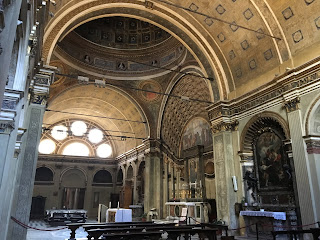
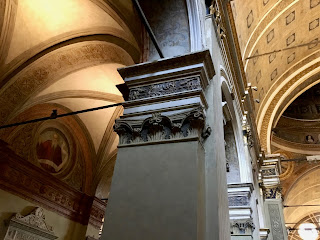






























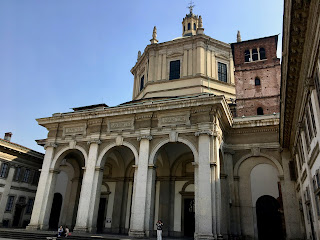










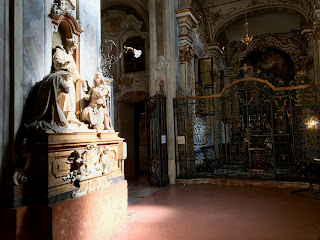








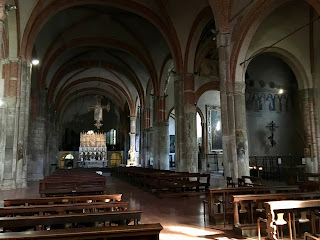












No comments:
Post a Comment